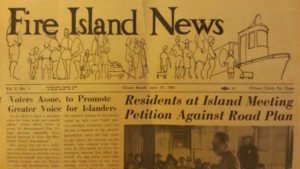Then and Now
By Thomas McGann
Introduction: With our eye on FIN’s 60 Anniversary, we sent History columnist Tom McGann a well-worn vintage copy of Fire Island News to get his perspective on what has changed and what remains the same on our beloved Fire Island. His insights might surprise you. We thank Ocean Beach Historical Society for their assistance with this project.

The June 17, 1961 edition of Fire Island News paints a portrait of life on Fire Island as viewed through a time kaleidoscope. The island is both easily recognizable and distorted at the same time. Printed in black and white type, color still manages to shimmer from those newspaper pages published over 55 years ago, words bringing history alive.
The frame is intact (the familiar Fire Island News logo remains largely unchanged), and, news being news, politics dominate the front page. RESIDENTS AT ISLAND MEETING PETITION AGAINST ROAD PLAN reads the headline. One might yawn at such old news, after all the fight against Robert Moses’ plan to build a road the length of Fire Island was won back in 1964, but to the residents who attended that meeting it was an uncertain future that yawned before them – vague and ugly – the same devious politics we continue to witness to this very day.
The Islip Town Supervisor at the time, Thomas Harwood, lied (as politicians are wont to do) about the purpose of a proposed right of way from Kismet to Ocean Beach. Its purpose was only for the use by emergency vehicles he insisted. One resident’s objection to “a road from nowhere to nowhere” was met with cheers. Those who fought the fight can still hear the echoes of those cheers today.
A sister piece to that article, also on the front page, describes the progress being made on the $10 million Fire Island Bridge that would join Long Island to Fire Island. Its completion date was scheduled for April 1964. In one of history’s ironic twists of fate, the Fire Island Bridge became part of the causeway named after Robert Moses. Today, the Robert Moses Causeway ends right where the road he planned down Fire Island was to begin – the road that was never built.
In opposition to the overwhelming sentiments of Fire Island residents, on the editorial page, under the paper’s masthead, the publishers came out in favor of the Kismet to Ocean Beach right of way. They then played both sides against the middle, noting that “no argument, no matter how strong, can stand up to the logicality of connecting two dead-end bridges.” They then encouraged all residents to join the newly formed Fire Island Voters Association in order to defeat the proposed Robert Moses road.
The publishers would change their minds over the intervening years and come out strongly against that road, but this editorial shows how tangled the situation was in June of ’61. You can almost smell the sweat in the newsroom as they struggled with this problem, an issue that only became even more strident until the establishment of the Fire Island National Seashore put an end to any plans for any roads.
Also on the editorial page was a News reprint entitled “Parental Responsibility” that seems oddly out of place in today’s world. Apparently, large groups of teenagers descended on Cherry Grove and the Pines the previous Memorial Day for a few hours of “wild fun … drinking, necking [a 1961 colloquial term meaning making out, kissing, whatever], and disorderly conduct.”
The editorial goes on to rebuke any teenager who would “drink himself into a stupor, smash windows, tear up a garden, or prove his manliness by beating up homosexuals.” The latitude of deference expressed here is mind boggling given the advances made by the LBGTQ community. One can barely imagine this being allowed to happen on Fire Island today.
The following pages describe house fires and a tragic local drowning, occurrences still too frequent, still being documented today. Then there is the story about 38 gold pieces found by one Benjamin Shalott as he made his rounds along the beach during the War of 1812. Stories of buried treasure on Fire Island are common, and, in some cases, accurate. Just as in yesteryear, the mere whisper of a new cache of gold doubloons buried somewhere on the beach is sure to bring out droves of treasure hunters armed with today’s most advanced metal detectors, delivered just yesterday by Amazon. (Of course it is illegal to operate metal detectors within National Park Service jurisdiction.)
There are Letters to the Editor (the subjects remain the same, only the names of the authors differ), Calendar of Events (same events, different years), Directory of Services (service guide to doctors, lawyers, fire chiefs, builders, boaters, bars and more. The latest edition lists the names of the grandsons and/or granddaughters of those posted in ‘61). Then as now, there is the ever-popular Police Blotter.
The recurrent crimes remain the same. Since the inception of Fire Island News, each community has the opportunity to express “what’s happening” in a column dedicated strictly to itself. Depending on who is counting and what they consider a town, the number of communities along the island varies from 18 to 21. Of these, usually 8 to 10 publish columns regularly. It is not surprising that most of the concerns are environmental and continue to be discussed year after year. Gala parties are also headlined as couples vie to be the most admired. Time marches on and a couple’s 50th anniversary too soon becomes their 75th.
There is usually a restaurant review, usually positive, usually spotlighting some restaurant new to the island. Gone are the Sea Turtle, and the Sea Shack, the Sandpiper (not the one we know today), John & Anne’s, Goldies, and numerous Bayviews – Sailor’s Haven even advertised their Seafarer’s Bar and night club entertainment unaware that they would be transformed into a National Park Service facility only five years later. But some have weathered Fire Island’s many storms, weather-wise and other-wise: Maguire’s, Flynn’s, Kismet Inn, the Casino, Blue Whale and a small handful of others, a small handful.
But one thing is missing and can, probably, never be replaced. Jules Feiffer published his pointed, political cartoon satires each week, an addition that gave Fire Island News Greenwich Village-cred, a sophistication welcomed by its readers. It is no more and, Jules, we miss you.
And so it goes. The more things change the more they remain the same, faithfully documented by Fire Island News, then and now.


























